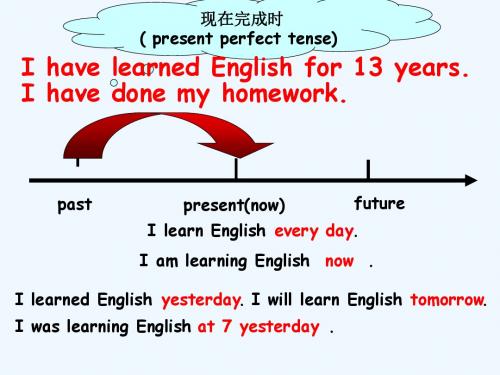英语人教版八年级下册现在完成时语法综合复习
- 格式:doc
- 大小:21.00 KB
- 文档页数:3

现在完成时(Ⅰ)1.现在完成时的含义现在完成时表示过去某一时间发生的动作或存在的状态对现在造成的结果和影响,或从过去某一时间开始一直持续到现在并有可能还会持续下去的动作或状态。
2.现在完成时的句式结构现在完成时是由“助动词have/has+过去分词”构成的,规则动词过去分词的构成是直接在单词后面加-ed,不规则动词的过去分词则需加强记忆。
肯定式主语+have/has+过去分词+其他.He has read this book before.他以前读过这本书。
否定式主语+haven't /hasn't+过去分词+其他.I haven't cleaned out the room.我还没清理干净房间。
疑问式Have/Has+主语+过去分词+其他?—Have you washed the clothes?你洗衣服了吗?—No,I haven't.没有,还没洗。
现在完成时的一般疑问句的答语:肯定回答:Yes,主语+have/has.否定回答:No,主语+haven't/hasn't.3.现在完成时与一般过去时的区别现在完成时一般过去时用法表示过去发生的动作对现在造成的影响,侧重于现在的情况。
表示过去某个时候发生的动作或存在的状态,与现在无关。
时间状语常和already,yet,just,ever,never,before,since,for等连用。
常和yesterday,last week,just now,in 2012,two days ago等具体的表示过去的时间状语连用。
谓语动词与一段时间连用时,谓语动词要用延续性动词而不用非延续性动词。
谓语动词没有延续性或非延续性动词的限制。





Revise the present perfect tense Ⅰ.Teaching Aims and Demands1.Knowledge ObjectsA. Revise the present perfect tense and the key words.B. Target Language1).—He has had a big breakfast.2). —What has happened to him/her?3). —He has just lost his job. She has just got a good job.4). — We have studied in our school for two years.5). — Peter has played tennis since last year.2 Ability Objects能把现在完成时运用到具体问题中。
3 Moral Object:Nothing is impossible if we work hard.Ⅱ. Teaching Key Points重点:1. 熟练现在完成时的用法。
2. 区分一般过去时与现在完成时。
Ⅲ. Teaching Difficult Points能具体分析现在完成时。
IV. Teaching Methods1.Teaching by giving sample sentences.2.Teaching by showing pictures.V. Learning strategiesUsing what you know, Inferring content教学过程:Step 1 Warm upShow the teaching aims to the students before the class. Greet the class.Invite students to answer the questions on the screen. Lead to revise the present perfect tense.Step 2 Look and thinkRevise the function and the structure of the present perfect tense.功能:1. 表示过去发生或已经完成的某一动作对现在造成的影响或结果。
人教版英语八年级下册Units 8-10语法重难点:现在完成时专项复习一. 定义:①过去发生的动作对现在造成的影响或结果:强调结果例:Yesterday I finished my homework, that’s to say, I have finished my homework now.②过去已经开始一直持续到现在的动作或状态:强调继续例:I have lived in Guangzhousince 2016, that’s to say, I have lived here for 4 years so far.二. 构成方法:现在完成时由“have (has)+过去分词”构成。
(have /has在现在完成时中作助动词;否定式: have/has not (缩写为haven’t/hasn’t) + 过去分词)三. 基本用法:(1)动作已完成(强调影响性)。
该用法的现在完成时表示一个过去发生的动作在过去已经完成,并且这个过去发生并完成的动作对现在产生影响或结果,同时说话强调的或感兴趣的就是这个影响或结果:She’s gone to bed. 她睡觉了。
(结果:她现在在床上)Have you seen my key? 你看到我的钥匙了吗?(结果:你知道它在哪里吗?)He has eaten nothing today. 他今天什么也没吃。
(结果:他现在一定很饿。
)(2)动作未完成(强调持续性)。
该用法的现在完成时表示一个过去发生的动作并未在过去完成,而是一直持续到现在,并且有可能继续下去(也可能到此结束):Have you waited long? 你等了很久吗?We have been busy this afternoon. 今天下午我们一直很忙。
I抳e waited a week for your answer. 等你的回答我等了一个星期。
除以上用法外,现在完成时还可表示过去的重复动作甚至将来动作:He has always gone to work by bike. 他总是骑自行车上班。
《现在完成时》教学设计
审坡中学李忠杰
教学目标:
1. 复习现在完成时的构成及其用法
2. 利用现在完成时解决实际问题
教学重难点:
1.如何判断动词要使用现在完成时以及与一般过去时的区别。
2.现在完成时的用法二,注意其中的动词必须用延续性动词。
教学步骤:
Step 1: Revision by doing exercises
1. Listen! Who ________(knock) at the door?
2. It is 12 o’clock. The Greens ________(have) lunch.
3. Where ________ Tom ________(come) from?
4. Bob _________(go) to school on foot every day.
5. I ________(not do) my homework last night.
6. Yesterday we _______(go) to the beach for vacation.
7. ______they _____(lose) their way just now?
8. Please bring your umbrella. It________ (rain) outsideStep2: Step
Step 2:Presentation
Now this class we will revise the tense “ the present continue tense”. First let’s revise the usage of it, the first usage :表示过去发生的动作对现在造成的影响或结果。
In order to help the students understand the grammar, tell them a oral song。
这种用法的标志词有just是刚刚, before是以前, ever是曾经, never是从不, already是已经,用在肯定中, yet是已经还,用在否定句或疑问句中。
例如:
Tom has just come back. Tom刚刚回来了。
I have already finished my homework.我已经完成我的作业。
Mary hasn’t fin ished her homework yet. Mary还没完成她的作业。
In order to help the students understand the tense, and then let them do the following exercises:
1. My father ________(not come) back yet.
2. I _______ never ________(be) to Beijing before.
3. They______ just______(read) this novel..
4. ________ you _______(see) the film once?
5. Tom ________already ________(finish) his work.
6. I _______ (lose) my key ,so I can’t open the door.
Step 3: go on revising the second usage :
表示从过去开始一直延续到现在的动作或状态。
在此必须强调动词必须是延续性动词。
这一点也是这一用法的重点和难点。
常见的非延续动词有come, start/ begin, buy, borrow, leave, die and so on. 在第二种用法中的标志词有for, since.即看到for或since时,动词必须转化成延续性动词,他们的转化关系如下:come 转化为be here 或be in; start/ begin 转化为be on; buy转化为 have; borrow 转化为keep; leave转化为 be away (from); die 转化为be dead。
例如:
我买这辆自行车两年了。
I have had the bike for two years.
他爷爷死了十年了。
His grandpa has been dead for ten years.电影上演十分钟了。
The film has been on for ten minutes.
另外理解for或since的用法也很重要。
Let the students understand “for” or “since” by doing exercises.
Tom has been in Beijing ______ ten years.
Our country has changed a lot ________1980.
He has made many friends _________ he came to this school. I have learned English _________ seven years.
通过以上练习题,他们会发现后for跟时间段;而since后跟时间点或从句。
注意:任何事物都不是一成不变的,通过上下文的理解来判断时态也很重要。
现在完成时和一般过去时的区别在于:尽管动作都是过去发生的,但如果和现在有关系要用现在完成时。
如:I have eaten lunch.我吃午饭的动作是
过去发生的,但对现在的影响是我不饿了。
I have lost my pen.钢笔丢了造成的影响是我没有钢笔了。
I lost my pen last night.只是强调昨晚发生丢钢笔这一动作。
Step 4: Exercises:
(一)用所给词的适当形式填空。
所以同学都要求掌握。
1. ______ you ________(read) the book before?
2. Tom _______ just _______( come) back.
3.I _______( have) an allergy since I ________( be) six.
4. My father ________( be) much healthier since he _______-( give)
up smoking.
5. where is your father? He ________( go) to work.
6. ________ you ________( finish) your homework?
Yes, I have.
When _______ you ________(finish) it?
Ten minutes ago.
7. How long _______ you ________(collect) stamps?
(二)翻译下列句子。
1. 这位老人死了三年了。
2. 格林一家来中国十年多了。
3.这部电影上演十分钟了。
4.我买这块手表四年了。
5. 我爸爸毕业二十年了。
Homework:
用现在完成时介绍一下你的假期生活。
例如你去过哪些城市,参观过哪些名胜古迹等等。